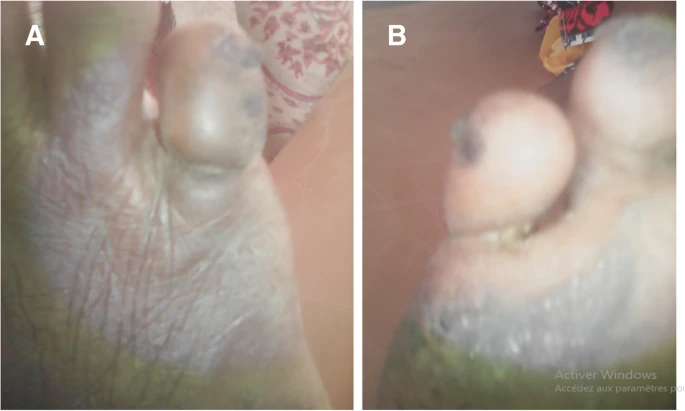
A 54-year-old female developed a constrictive ring on her toe. This ring first appeared 6 months ago on her right fifth toe without any history of wound or trauma
The patient did not report any comorbidities such as diabetes or ischemic heart disease. She did not smoke and was negative for any family history of dermatological diseases. On clinical examination, she was well-oriented. Her vitals were within normal range. Doctors did not find any palpable lymph nodes. Overall, the patient looked fine except for a constrictive ring on her toe. Thus after labelling it a toe infection, they started treatment with cefuroxime (a third-generation cephalosporin) and some paracetamol and diclofenac. They kept her on these drugs for a week with a regular change of dressing every two days.
No Change in Constrictive Ring even After a Week!
Doctors re-assessed the patient after one week of antibiotic therapy. To their dismay, they noticed a progression in the constrictive ring on the patient’s toe. So much that it was auto-amputating the distal toe. Moreover, the patient reported experiencing severe pain when trying to move the affected toe. Hence, doctors ran some more tests, from CBC to CRP and ESR, to probe out the underlying cause. Results revealed elevated values for both CRP and ESR. Based on these and their findings on clinical examination doctors made a diagnosis of stage four ainhum.
Ainhum: An Insight
Ainhum is a rare dermatological disease with very few cases documented so far. It usually affects people living in the African regions, males more than females. The disease manifests classically as constrictive bands or rings around the fifth toes. In three fourth of the cases, both fifth toes develop the disease. Even the great toe can get affected. Anyhow, ainhum rarely involves a single toe and it develops even rarely in people outside of African descent.
The cause of ainhum is variable. Most cases of the disease develop idiopathically. However, according to doctors, the disease can also develop due to a fungal or mycobacterial infection. Moreover, trauma and causes such as compromised blood supply and peripheral neuropathy can also lead to disease development. Not to mention, the disease also has a genetic origin according to some hypotheses. Whatever the cause may be, ainhum sets in as constrictive bands/rings that progress and push the affected toes towards auto-amputation.
How to Establish a Diagnosis?
Diagnosis mainly depends upon clinical findings and doctors make a diagnosis after analyzing three characteristic features. These include soft tissue destruction and constrictive ring formation, thinning of the phalangeal bone and eventually separation of the phalanx. From initially affecting the toe to climbing up to causing auto-amputation, the disease passes through four stages. It sets in as a clavus formation that later turns into a ring-like fissure. In the second stage, the toe distal to the fissure develops globular swelling. This stage involves bone resorption and arterial narrowing. In the third stage, the bone starts to separate and the joint become hypermobile. The fourth and final stage involves bloodless auto-amputation of the toe associated with serious pain. Our patient presented with stage four ainhum as she had an impending auto-amputation. Anyhow, differentials for the disease include pseudoainhum and keratoderma. These can also be ruled out on an X-ray which will show constricting rings and signs of bone resorption in the distal phalanx.
Treatment of Our Patient With Constrictive Ring on her Toe
Ainhum if caught early, in stage 1 or 2, can be managed with medical therapy. Employment of drugs such as salicylates and steroids shows good outcomes. In addition, the band/ring is released through a surgical Z-plasty. However, for stages 3 and 4, surgical amputation of the toe becomes inevitable. It should be done as soon as possible to provide pain relief and avoid infections. Letting the disease progress to auto-amputation significantly elevates the risk for secondary infections and other threatening complications.
Our patient came in with stage four aihum with impending auto-amputation. So, the doctors prepped her with 2 percent lidocaine ( local anaesthesia) for surgical amputation of her toe. They disarticulated the toe at the metatarsophalangeal joint and then stitched back the skin. Fortunately, the post-operative events turned out insignificant and doctors discharged the patient on her seventh post-op day. There have not been any developments in the case since then.



